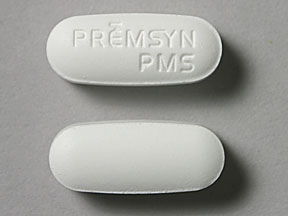Premsyn PMS Interactions
There are 534 drugs known to interact with Premsyn PMS (acetaminophen/pamabrom/pyrilamine), along with 11 disease interactions, and 1 alcohol/food interaction. Of the total drug interactions, 20 are major, 500 are moderate, and 14 are minor.
- View all 534 medications that may interact with Premsyn PMS
- View Premsyn PMS alcohol/food interactions (1)
- View Premsyn PMS disease interactions (11)
Most frequently checked interactions
View interaction reports for Premsyn PMS (acetaminophen / pamabrom / pyrilamine) and the medicines listed below.
- acetaminophen
- Advil (ibuprofen)
- aloe vera
- amoxicillin
- Atarax (hydroxyzine)
- Benadryl (diphenhydramine)
- betaine
- biotin
- chromium picolinate
- Citracal + D (calcium / vitamin d)
- Claritin (loratadine)
- Claritin 24 Hour Allergy (loratadine)
- CoQ10 (ubiquinone)
- Darpaz (hyoscyamine / methenamine / methylene blue / phenyl salicylate / sodium biphosphate)
- Digipepsin (pancreatin)
- Ditropan XL (oxybutynin)
- Fioricet (acetaminophen / butalbital / caffeine)
- Ginger Root (ginger)
- Glucosamine & Chondroitin with MSM (chondroitin / glucosamine / methylsulfonylmethane)
- hydrochlorothiazide
- Levsin (hyoscyamine)
- loratadine
- lorazepam
- magnesium oxide
- melatonin
- Omega 3-6-9 Complex (omega-3 polyunsaturated fatty acids)
- promethazine
- Vitamin C (ascorbic acid)
- Vitamin D3 (cholecalciferol)
- Zoloft (sertraline)
Premsyn PMS alcohol/food interactions
There is 1 alcohol/food interaction with Premsyn PMS (acetaminophen / pamabrom / pyrilamine).
Premsyn PMS disease interactions
There are 11 disease interactions with Premsyn PMS (acetaminophen / pamabrom / pyrilamine) which include:
- alcoholism
- liver disease
- depression
- PKU
- anticholinergic effects
- asthma/COPD
- cardiovascular
- renal/liver disease
- glaucoma
- liver disease
- hypokalemia
More about Premsyn PMS (acetaminophen / pamabrom / pyrilamine)
- Premsyn PMS consumer information
- Compare alternatives
- Reviews (1)
- Drug images
- Side effects
- Drug class: analgesic combinations
Related treatment guides
Drug Interaction Classification
| Highly clinically significant. Avoid combinations; the risk of the interaction outweighs the benefit. | |
| Moderately clinically significant. Usually avoid combinations; use it only under special circumstances. | |
| Minimally clinically significant. Minimize risk; assess risk and consider an alternative drug, take steps to circumvent the interaction risk and/or institute a monitoring plan. | |
| No interaction information available. |
Further information
Always consult your healthcare provider to ensure the information displayed on this page applies to your personal circumstances.


